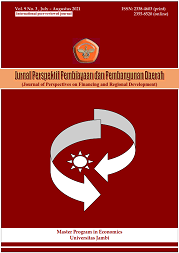Identifying spatial correlation and factors influencing regional economic growth in Southern Sumatra
DOI:
https://doi.org/10.22437/ppd.v9i3.13422Keywords:
Local Indicator, Morans’I index, Spatial Autocorrelation, Spatial PanelAbstract
This study analyzes the spatial autocorrelation of economic growth and labor and the factors that influence economic growth between districts/cities in the Southern Sumatra region. The data used is secondary data sourced from the Bureau of Central Statistics. The method used is a quantitative approach by applying the Moran Index, LISA, and multiple regression models. This study shows that the spatial autocorrelation of economic growth did not occur in the Southern Sumatra region. Meanwhile, the spatial autocorrelation of labor occurs in this region so that it affects each other. This study’s finding that jointly the variables of potential market indicator, fixed capital investment, human capital, and labor force participation rate have a significant effect on GRDP. Likewise, partially the potential market indicators, capital fixed asset investment, human resources, and labor force participation rates have a positive and significant effect on GRDP.
Downloads
References
Adifa, Y. (2007). Analisis Kesenjangan Pembangunan Antar Wilayah Pembangunan Di Kabupaten Alor Provinsi Nusa Tenggara Timur. [Master Theses]. Institut Pertanian Bogor.
Bawono, N. (2011). Keterkaitan Spasial Perbedaan Produktivitas Tenaga Kerja Kabupaten/Kota Di Pulau Jawa. [Master Theses]. Institut Pertanian Bogor.
Bendavid-Val, A. (1991). Regional and Local Economic Analysis for Practitioners. New York: Greenwood Publishing Group, Inc.
Boukebbab, S., & Boulahlib, M. S. B. (2015). The Spatial Interactions Using the Gravity Model: Application at the Evaluation of Transport Efficiency at Constantine City, Algeria. Advances in Intelligent Systems and Computing, 365, 305–318. https://doi.org/10.1007/978-3-319-19216-1
Bräuninger, M., & Niebuhr, A. (2011). Agglomeration, Spatial Interaction and Convergence in the EU. SSRN Electronic Journal. https://doi.org/10.2139/ssrn.756725
Dewi, A. E. P., & Masbar, R. (2016). Aglomerasi dan Pemanfaatan Ruang di Kota Banda Aceh. Jurnal Ilmiah Mahasiswa (JIM), 1(2), 311–320.
Heryanti, Y., Junaidi, & Yulmardi. (2014). Interaksi Spasial Perekonomian dan Ketenagakerjaan Antar Kabupaten/Kota di Provinsi Jambi. Jurnal Perspektif Pembiayaan Dan Pembangunan Daerah, 2(2), 99-106
Lee, J., & Wong, D. W. S. (2001). Statistical Analysis with Arcview GIS. New York: John Wiley and Sons.
Mariana. (2013). Pendekatan Regresi Spasial Dalam Pemodelan Tingkat Pengangguran Terbuka. Jurnal Matematika Dan Pembelajaranya, 1(1), 42–63.
Nizar, C., Hamzah, A., & Syahnur, S. (2013). Pengaruh Investasi dan Tenaga Kerja Terhadap Pertumbuhan Ekonomi Serta Hubungannya Terhadap Tingkat Kemiskinan di Indonesia. Jurnal Ilmu Ekonomi, 1(2), 1-8.
Odit, M. P., Dookhan, K., & Fauzel, S. (2018). The impact of education on economic growth: The case of India. International Business & Economics Research Journal, 66(1), 253–262. https://doi.org/10.11118/actaun201866010253
Perloff, H., & Wingo, L. J. (1961). Economic Growth Natural Resources and Economic Growth. In Joseph (Ed.), Natural Resources Endowment and Regional. Washington D.C: Resouces for the Future.
Scardaccione, G., Scorza, F., Casas, G. Las, & Murgante, B. (2010). Spatial autocorrelation analysis for the evaluation of migration flows: The Italian case. Lecture Notes in Computer Science (Including Subseries Lecture Notes in Artificial Intelligence and Lecture Notes in Bioinformatics), 6016 LNCS(PART 1), 62–76. https://doi.org/10.1007/978-3-642-12156-2-5
Soares, L., Rustiadi, E., & Mulatsih, S. (2017). Analisis Disparitas dan Interaksi Spasial di Tomor-Leste. Journal of Regional and Rural Development Planning, 1(1), 74–86.
Wenqing, P. (2013). Regional Correlation and Spatial Spillovers in China’s Regional Economic Growth. Social Sciences in China, 34(3), 125–139. https://doi.org/10.1080/02529203.2013.820566
Zhukov, Y. M. (2010). Applied Spatial Statistics in R , Section 4 Spatial Point Processes Spatial Data and Basic Visualization in R. Statistics, 1–18.
Downloads
Published
How to Cite
Issue
Section
License
Copyright (c) 2021 Nengsi Puspita Dewi, Tanti Novianti, Dedi Budiman Hakim

This work is licensed under a Creative Commons Attribution 4.0 International License.





















